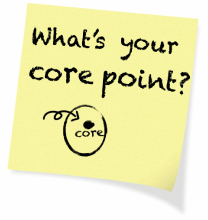Presentation Zen: Simple Ideas on Presentation Design and Delivery, 2nd Edition (Ira Katz's Library) (11 page)
Authors: Garr Reynolds

If you prepare well, and really get your story down pat—well enough to pass the elevator test—then you can sell your core message well in any situation. A friend of mine, Jim in Singapore, sent me an e-mail sharing a good example of what can happen when you do this work in the preparation stage.
Dear Garr... got this new prospect and have been trying to get in front of the guy for months. Finally get the word he’ll see me next week.
I know he is a super short attention span guy so I used a simple approach and agonized over the content and the key message and then the graphics. We get to the office and begin with the usual small talk that starts a meeting and suddenly I realize we’ve gone over the points of the presentation in our conversation and he has agreed to move forward. Then he looks at his watch and says great to see you thanks for coming in. As we walk out of the building the two guys that work for me say hey you never even pulled out the presentation and he still bought the deal—that was great!
Meanwhile I’m in a complete funk: “What about all my preparation time? He never even saw my presentation. What a waste of time putting the whole thing together!” Then the light went on. Presentation preparation is about organizing thoughts and focusing the storytelling so it’s all clear to your audience. I was able to articulate the points because I had worked those through in the preparation of the presentation. Even the graphics had made me think the presentation through and became a part of the presentation even though the audience never saw them.
Jim makes an excellent point here. If you prepare well, the process
itself
should help you really know your story. With proper preparation, you should be able to still tell your story even if the projector breaks or if the client says, “To heck with the slides, just give it to me straight.”
The planning stage should be the time when your mind is most clear with all barriers removed. I love technology, and I think slideware can be very effective in many situations. But for planning, go analog: Use a paper and pen, whiteboards, a notepad in your pocket as you walk down the beach with your dog...whatever works for you. Peter Drucker said it best: “The computer is a moron.” You and your ideas (and your audience) are all that matter. So try getting away from the computer in the early stages when your creativity is needed most. For me, clarity of thinking and the generation of ideas come when my computer and I are far apart.
The purpose behind getting off the grid, slowing down, and using paper or whiteboards during the preparation stage is to better identify, clarify, and crystallize your core message. Again, if your audience remembers only one thing, what should that be? And why? By getting your ideas down and your key message absolutely clear in your mind and on paper first, you’ll be able to organize and design slides and other multimedia that support and magnify your content.

• Slow down your busy mind to see your problem and goals more clearly.
• Find time alone to see the big picture.
• For greater focus, try turning off the computer and going analog.
• Use paper and pens or a whiteboard to record and sketch out your ideas.
• Key questions: What’s your main (core) point? Why does it matter?
• If your audience remembers only one thing, what should it be?
• Preparing a detailed handout keeps you from feeling compelled to cram everything into your visuals.


During your time off the grid, you brainstormed alone or perhaps with a small group of people. You stepped back to get the big picture, and you identified your core message. You now have a clearer picture of the presentation content and focus even if you do not have all the details worked out yet. The next step is to give your core message and supporting messages a logical structure. Structure will help bring order to your presentation and make it easier for you to deliver it smoothly and for your audience to understand your message easily.
Before you go from analog to digital—taking your ideas from sketches on paper and laying them out in PowerPoint or Keynote—it is important to keep in mind what makes your ideas resonate with people. What makes some presentations absolutely brilliant and others forgettable? If your goal is to create a presentation that is memorable, then you need to consider how you can craft messages that stick.
One of the components for creating sticking messages is story. We tell stories all the time. Think about times you may have been camping with a group of people, taking a tiny step back to a more primitive time, where the evening develops into long sessions of storytelling around the campfire. There is something very natural, compelling, and memorable about both telling and listening to stories.
Most of the great books that will help you make better presentations are not specifically about presentations at all, and they are certainly not about how to use slideware. One such book is
Made to Stick
(Random House) by Chip and Dan Heath. The Heath brothers were interested in what makes some ideas effective and memorable and others utterly forgettable. Some stick, and others fade away. Why? What the authors found—and explain simply and brilliantly in their book—is that “sticky” ideas have six key principles in common: simplicity, unexpectedness, concreteness, credibility, emotions, and stories. And yes, these six compress nicely into the acronym SUCCESs.
The six principles are relatively easy to incorporate into messages—including presentations and keynote addresses—but most people fail to use them. Why? The authors say the biggest reason most people fail to craft effective or “sticky” messages is because of what they call the “Curse of Knowledge.” The Curse of Knowledge is essentially the condition whereby the deliverer of the message cannot imagine what it’s like not to possess his level of background knowledge on the topic. When he speaks in abstractions to the audience, it makes perfect sense to him but him alone. In his mind, it seems simple and obvious. The six principles—SUCCESs—are your weapons, then, to fight your own Curse of Knowledge (we all have it).
Here’s an example the authors used early in their book to explain the difference between a good, sticky message and a weak garden-variety message. Look at these two messages, which address the same idea. One of them should seem very familiar to you.
“Our mission is to become the international leader in the space industry through maximum team-centered innovation and strategically targeted aerospace initiatives.”
Or
“...put a man on the moon and return him safely by the end of the decade.”
The first message sounds similar to CEO-speak today and is barely comprehensible, let alone memorable. The second message—which is actually from a 1961 speech by John F. Kennedy—has every element of SUCCESs, and it motivated a nation toward a specific goal that changed the world. JFK, or at least his speechwriters, knew that abstractions are not memorable, nor do they motivate. Yet how many speeches by CEOs and other leaders contain phrases such as “maximize shareholder value yada, yada, yada?” Here’s a quick summary of the six principles from
Made to Stick
that you should keep in mind when crystallizing your ideas and crafting your message for speeches, presentations, or any other form of communication.
•
Simplicity.
If everything is important, then nothing is important. If everything is a priority, then nothing is a priority. You must be ruthless in your efforts to simplify—not dumb down—your message to its absolute core. We’re not talking about stupid sound bites here. Every idea can be reduced to its essential meaning if you work hard enough. For your presentation, what’s the key point? What’s the core? Why does (or should) it matter?
•
Unexpectedness.
You can get people’s interest by violating their expectations. Surprise people. Surprise will get their interest. But to sustain their interest, you have to stimulate their curiosity. The best way to do that is to pose questions or open holes in people’s knowledge and then fill those holes. Make the audience aware that they have a gap in their knowledge and then fill that gap with the answers to the puzzle (or guide them to the answers). Take people on a journey.
•
Concreteness.
Use natural speech and give real examples with real things, not abstractions. Speak of concrete images, not of vague notions. Proverbs are good, say the Heath brothers, at reducing abstract concepts to concrete, simple, but powerful (and memorable) language. For example, the expression
iiseki ni cho
or “kill two birds with one stone” is easier than saying something like “let’s work toward maximizing our productivity by increasing efficiency across many departments.” And the phrase “go to the moon and back” by JFK (and Ralph Kramden before him)? Now that’s concrete. You can visualize that.
•
Credibility.
If you are famous in your field, you may have built-in credibility (but even that does not go as far as it used to). Most of us, however, do not have that kind of credibility, so we reach for numbers and cold, hard data to support our claims as market leaders and so on. Statistics, say the Heath brothers, are not inherently helpful. What’s important is the context and the meaning. Put it in terms people can visualize. “Five hours of battery life” or “Enough battery life to watch your favorite TV shows nonstop on your iPod during your next flight from San Francisco to New York”? There are many ways to establish credibility—a quote from a client or the press may help, for example. But a long-winded account of your company’s history will just bore your audience.
•
Emotions.
People are emotional beings. It is not enough to take people through a laundry list of talking points and information on your slides; you must make them
feel
something. There are a million ways to help people feel something about your content. Images are one way to have audiences not only understand your point better but also have a more visceral and emotional connection to your idea. Explaining the devastation of the Katrina hurricane and floods in the United States, for example, could be done with bullet points, data, and talking points. But images of the aftermath and the pictures of the human suffering that occurred tell the story in ways words, text, and data alone never could. Just the words “Hurricane Katrina” conjure vivid images in your mind. Humans make emotional connections with people, not abstractions. When possible, put your ideas in human terms. “100 grams of fat” may seem concrete to you, but for others it is an abstraction. A picture of an enormous plate of greasy French fries, two cheeseburgers, and a large chocolate shake will hit people at a more visceral level. “So that’s what 100 grams of fat looks like!”
